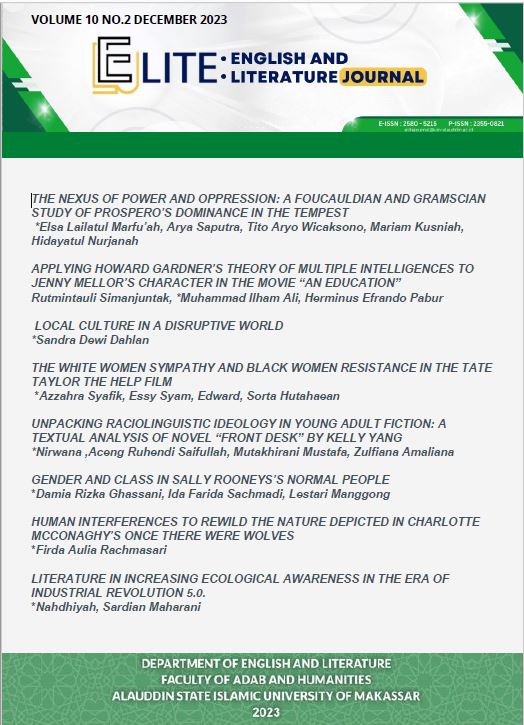LOCAL CULTURE IN A DISRUPTIVE WORLD
Abstract
This study aimed to describe the implementing digitizing folklore in the English Drama Course to the students of English and Literature Department. In addition, to evaluate the student responses to the project as part of cultural preservation efforts. This study used mixed methods to collect qualitative and quantitative data. The population of the research were fourth semester students of class AG 2/3 of English and Literature Department of UIN Alauddin Makassar. The object was the English Drama Course by applying the "Active Learning" model in the form of digitizing local folklore into animated video. The research technique was carried out by means of observation, interviews and surveys to answer the research questions. The results showed that this project has succeeded in presenting an educational and entertaining animated video for the public watch. In addition, all students involved have responded positively to the implementation of the project and considered the process and implementation were successful and satisfying, especially as an effort to preserve local culture and promote cultural education.
Downloads
References
Amin, F. (2011). Preservasi Naskah Klasik. Jurnal Khatulistiwa – Journal Of Islamic Studies Volume 1 (1)
Asaniyah, N. (2017). Pelestarian Informasi Koleksi Langka: Digitalisasi, Restorasi, Fumigasi. Buletin Perpustakaan No. 57
Astina, Kadek A. D. (2020). Menciptakan Buku Dongeng Digital Sebagai Upaya Mempertahankan Tradisi Mendongeng Di Era Modern. In Prosiding Seminar Nasional Desain dan Arsitektur (SENADA) Vol.3, Maret 2020 p-ISSN 2655-4313 (Print), e-ISSN 2655-2329 (Online)
Creswell, J. W. (2012). Educational Research: Planning, Conducting, And Evaluating Quantitative And Qualitative Research. 4th edition, Boston: Pearson.
Danandjaya, J. (2007). Folklor Indonesia: Ilmu Gosip, Dongeng dan Lain-lain. Jakarta: Pustakan Utama Grafiti.
Dharsana, I. K, et al., (2016). Digitalisasi Cerita Rakyat Dalam Rangka Pelestarian Budaya Berbasis Aplikasi Mobile. Seminar Nasional Vokasi dan Teknologi (SEMNASVOKTEK).
Hendrawaty, T. (2018). Digitalisasi Manuskrip Nusantara Sebagai Pelestari Intelektual Leluhur Bangsa. Ejournal Perpusnas Vol. 25 No. 4
Johnson, R. B. and Onwuegbuzie, A. J. (2004). Mixed methods research: A research paradigm whose time has come. Educational Researcher, 33(7), 14-26.
Kumbara, AA.N.A., Dewi, AA.S.K., Liando, M.R., Wiasti, M. (2020). Disrupsi Budaya Dan Tantangan Antropologi Dalam Pembangunan Masyarakat Multikultural. ETNOSIA: Jurnal Etnografi Indonesia. 5(1): 5 –14. DOI: 10.31947/etnosia.v5i1.8679
Latiar, H. (2018). Preservasi Naskah Kuno Sebagai Upaya Pelestarian Budaya Bangsa. Al-Kuttab: Jurnal Perpustakaan dan Informasi. 5. 67. 10.24952/ktb.v5i1.827.
Saputra, H. S. P., et al., (Eds.). (2020). Humaniora dan Era Disrupsi. E-Prosiding Seminar Nasional Pekan Chairil Anwar. Jember University Press.
Savanti, D. (2018). Seruan Pelestarian Warisan Sastra dan Budaya Daerah Digaungkan di Kongres Kebudayaan Indonesia 2018. (https://kniu.kemdikbud.go.id/?p=3692)
Sihombing, Agus Setiadi. (2020) Era Disrupsi, Ancaman atau Peluang terhadap Ketahanan Budaya Lokal?. 1 Mei 2020 23:03 Diperbarui: 1 Mei 2020 23:49 (https://www.kompasiana.com/agussetiadisihombing/5eac4838d541df0569628493/era-disrupsi-ancaman-atau-peluang-terhadap-ketahanan-budaya-lokal)
Sugiyono. (2010). Metode Penelitian Pendidikan Pendekatan Kuantitatif, Kualitatif, dan R&D. Bandung: Alfabeta
Wrenn, J., and Wrenn, B. (2009). Enhancing Learning by Integrating Theory and Practice. International Journal of Teaching and Learning in Higher Education 2009, Volume 21, Number 2, 258-265
Copyright (c) 2023 Sandra Dewi Dahlan

This work is licensed under a Creative Commons Attribution-NonCommercial-ShareAlike 4.0 International License.
Once an article was published in the journal, the author(s) are:
granted to the journal right licensed under Creative Commons License Attribution that allows others to share the work with an acknowledgement of the work's authorship.
permitted to publish their work online in third parties as it can lead wider dissemination of the work.
continue to be the copyright owner and allow the journal to publish the article with the CC BY-NC-SA 4.0 license
receiving a DOI (Digital Object Identifier) of the work.


